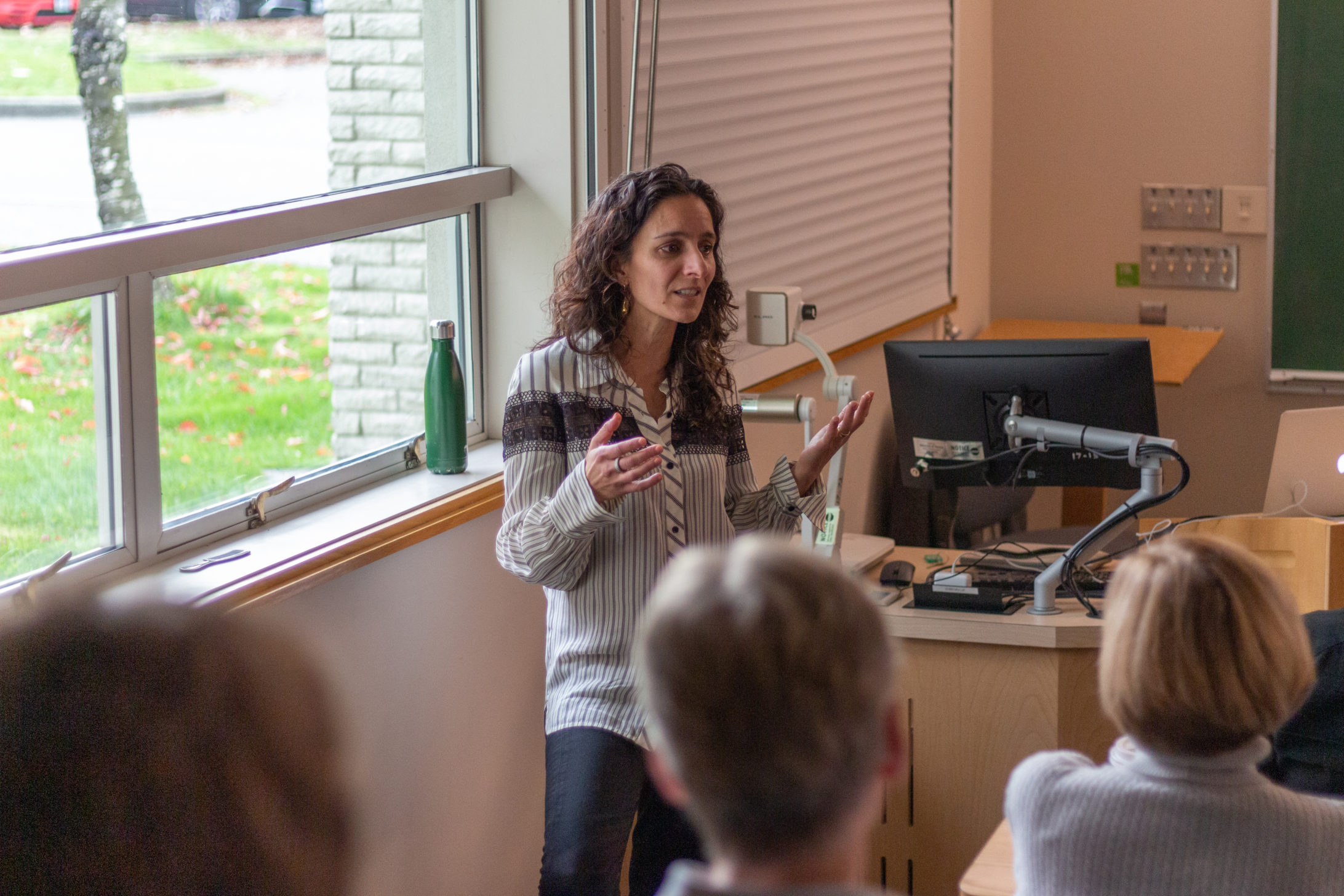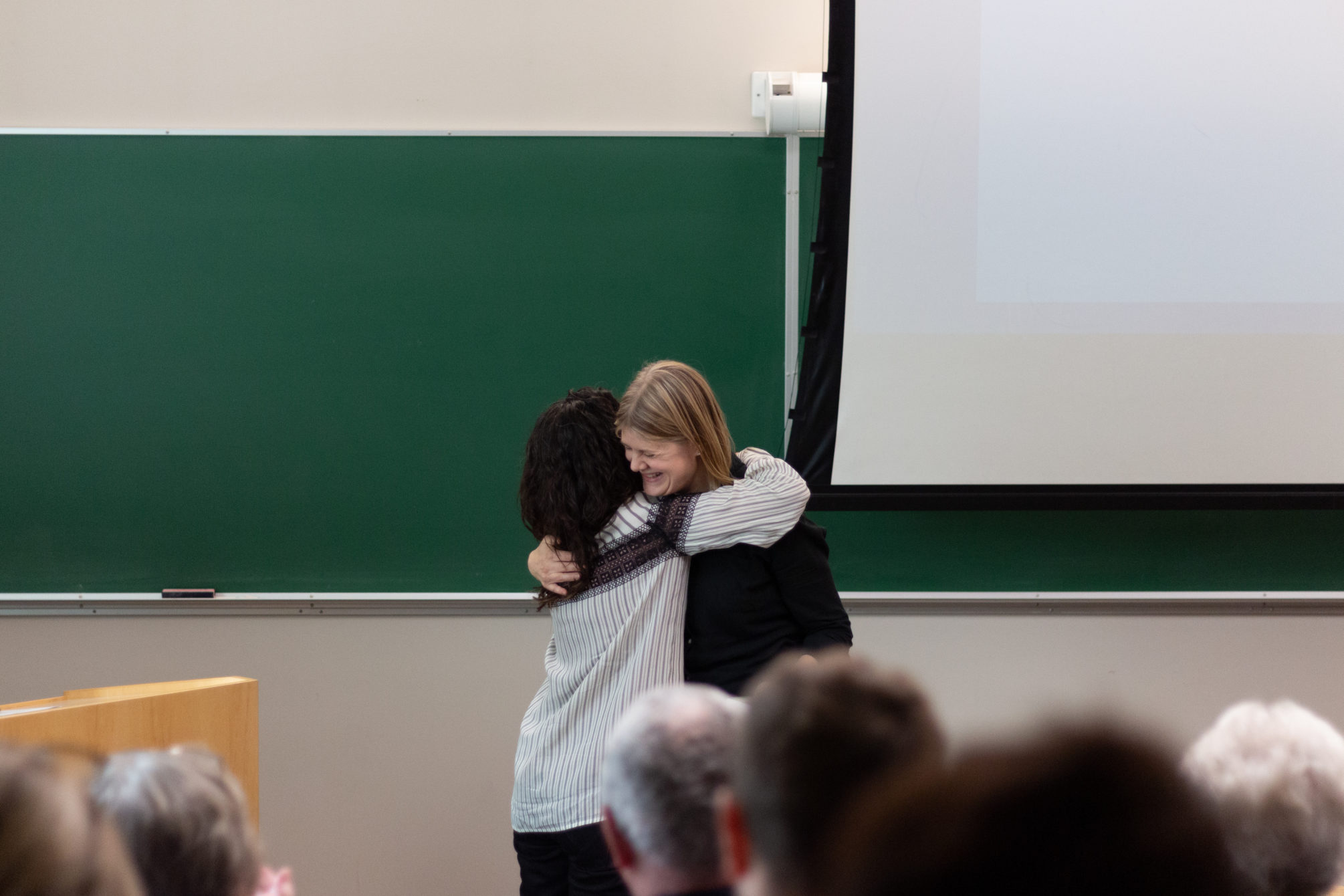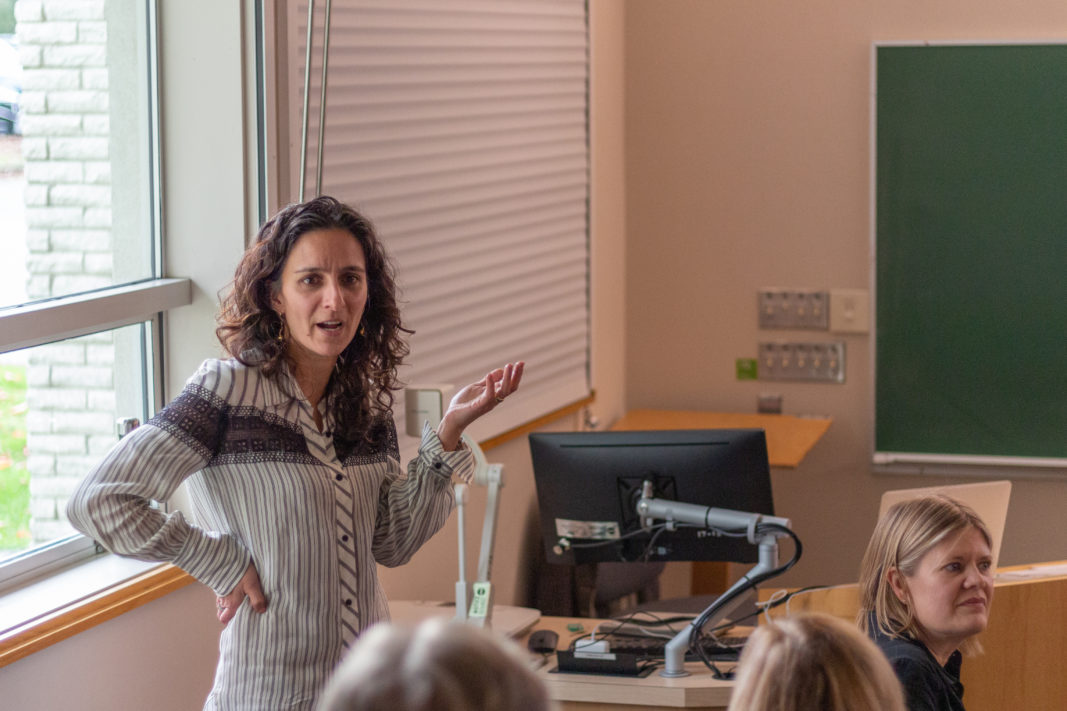“Iraq and Haida Gwaii — that can only be one person”
Farah Nosh started journalism school on September 11, 2001. In retrospect, she says this foreshadowed a lot of what was to come for her. She skipped writing classes to watch coverage of the war in Afghanistan, becoming ever more engaged with the post-9/11 narrative.
One year later, Nosh boarded a plane to the Middle East, beginning an award-winning career that took her to Iraq, Afghanistan, Lebanon, Syria, Gaza, the West Bank, Egypt, and Pakistan; included the New York Times, TIME magazine, and Newsweek; and fuelled several passion projects such as “Wounded Iraq” and “Language at Risk, Haida,” the latter of which features portraits of the few remaining fluent speakers of the Haida language.
On Oct. 23, Nosh stood at the front of a packed room in the UVic Fine Arts building and spoke about trauma, healing, compassion, and telling stories that are not her own. She came to UVic as the 2019 Harvey Southam lecturer, thanks to the Harvey Stevenson Southam Lecture Fund in Journalism and Non-Fiction that allows UVic to invite a visiting lecturer and journalist-in-residence to the university every year.
As an Iraqi-Canadian, Nosh felt the impact of 9/11 on a personal level. She recalled working at an Earl’s restaurant as a journalism student, when she overheard a customer say, “Well clearly it’s the Palestinians or the Iraqis.”
Nosh remembers walking away from the table and saying to herself, “Oh shit, here we go again.”
As a teenager in the 1990s, Nosh had experienced the “heightened demonization and othering” of being Iraqi in Canada during the Persian Gulf War.
“The Iraq War would not have happened if 9/11 hadn’t happened,” said Nosh. “And yet, what did 9/11 [have to do] with [the Iraq War]? And so, it only seemed natural — and yet so crazy, now that I look back on it — that I would go.”
And so she went, one year after the towers fell. Running back, as her father called it, to the country that he left so that his daughter could have a better life.
Nosh describes herself as a “humanist photographer,” committed to translating the daily human suffering of the Iraq War.
Nosh arrived in Baghdad fresh out of journalism school.
“I kinda showed up at the press centre so green,” said Nosh. “Totally naive. Like, not realizing the press centre is also the centre of Iraqi intelligence.”
That didn’t last long. Nosh’s photographer heroes were also based in Baghdad, and knowing she had a lot to learn, she attached herself to mentors. They were hard on her. Nosh recounted an incident in which Jerome Delay of the Associated Press looked over some of her work, picked up her flash, told her to get rid of it, and threw it across the room. It landed in the garbage can. Even so, she calls working with those photographers a gift.
Nosh describes herself as a “humanist photographer,” committed to translating the daily human suffering of the Iraq War.
“I knew that the demonization that we were experiencing of the Iraqi narrative was something I was looking to transform and change,” said Nosh. She was inspired by the photography of the Vietnam War that helped shape public opinion of that conflict, and believed that the same could be done in Iraq.
Nosh paused for a moment before diving into the emotional content that she came to UVic to talk about.
“I guess we just get into [it],” she said. “I guess it never occurred to me at the time that my camera’s engagement with humanity would become the greatest gift and yet the greatest burden at the same time.”
She described how the trauma of working in Iraq, of recording the intense suffering of people living under the conflict and risking her own life to do so, slowly crept up on her.
“Anyone who has the experience with trauma knows that it’s not like it comes knocking on your door … it’s something that just slowly and quietly makes its way into your cellular structure, you know,” she said. “When I first started realizing it, it was like a visceral, cellular reaction that I had that was triggered by something — by fireworks, once.”
After years of being intimately involved with conflict in the Middle East, Nosh finally had to accept that PTSD was taking a toll on her mind. She began retreating to Haida Gwaii, where she recalls moving around Haida Gwaii with her head down, trying to hide the fact that something was wrong.
But she couldn’t hide from the Haida elders, with whom she was working on her project of taking portraits of fluent Haida speakers.
“In 2006 I had this insane summer of piles of dead kids,” said Nosh, “and I had walked into the longhouse, and I remember where I was, and Grace Jones was standing there, one of [the] fluent speakers, and [she] looked at me and all she had to say was ‘oh no.’”
Despite continuing to return to the Middle East, Nosh said she now had a place to heal, a process helped by ceremonies offered to her by the Haida elders. She continued to struggle, but was never again in as dark a place as she once had been.
“I was really back and forth in my two worlds pretty steadily, and I think that, you know, in a way I had convinced myself that retreating to Haida Gwaii was just enough to keep me going so I could keep getting into this work,” said Nosh.
Nosh took around 5 000 photos during the two-day Potlach, and calls it “one of the most profound and meaningful moments of photography [she] ever had.”
But, eventually, she realized that what she was doing was unsustainable. Not only was her work traumatizing, it was also incredibly dangerous, and the close calls were adding up. Two or three times a year, Nosh said, she would pray and promise that she would never do this again if she could just get out of this scrape, be it an Israeli drone, an IED, or being chased down a highway by masked gunmen. But then she would decide to keep going for just one more year.
“Eventually I realized that I wasn’t recalibrating enough, and that the burdens of knowing were actually not really worth it,” said Nosh. “And I started convincing myself that [the] idealism of my late twenties that I had gone in with [was] no longer serving me, that I sort of had to reevaluate the reality of the situation — which was really that even though I might have brought the daily Iraqi war experience into homes with, you know, a full-page New York Times spread, that wasn’t enough for me.”
The narrative wasn’t transforming in the way Nosh had once believed it could be, and the impact on her own life and health was no longer worth simply starting conversations. Screen culture, she noted, is contributing to decreasing compassion and increasing narcissism –– perhaps the sort of media-driven shift in public opinion that happened with the Vietnam War is no longer possible, despite the greater accessibility of media content. Additionally, she was now in her mid-thirties, and thinking about starting a family.
Even so, “the greatest obstacle for me getting out of that work was ego,” said Nosh. Her work had brought her awards and international renown, and, having convinced herself that she was serving a purpose, documenting other narratives seemed meaningless.
But, Haida Gwaii saved Nosh once again. After coming back from her last Middle Eastern stint, she continued collaborative work with the Haida Nation, which culminated in her “Potlach Series” of portraits. Nosh took around 5 000 photos during the two-day Potlach, and calls it “one of the most profound and meaningful moments of photography [she] ever had.”
Coming from a background of “war chaos reportage [that] has no room, no time for formalities,” Nosh’s Middle Eastern work frequently required her to photograph highly emotional moments without asking permission. Nosh now emphasizes the importance of collaboration in her work with the Haida Nation. The work doesn’t belong to her, she said, it belongs to the community, and she asks for permission to use it and guidance in how best to do so.
Nosh will continue to work as a humanist photographer driven by compassion and empathy –– she just won’t be in war zones. She recently received a grant to expand her work with fluent speakers of at-risk languages globally, a project to which she has an intense personal connection. Just as she was able to bring her Iraqi heritage to her work in the Middle East, Nosh also understands how language can influence ways of being through her experience of learning her own language, Arabic.











